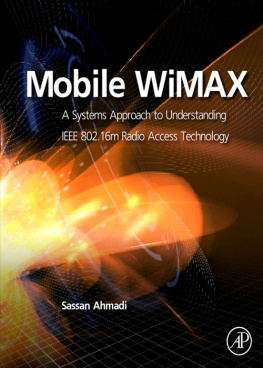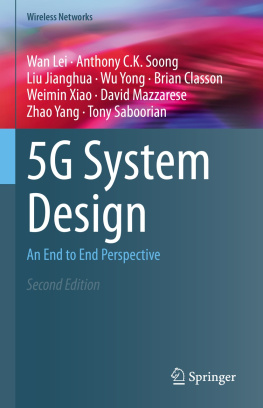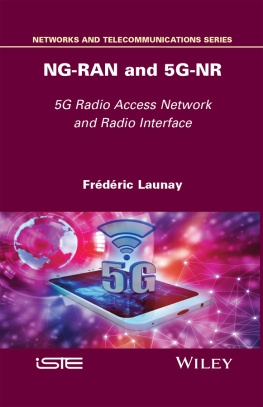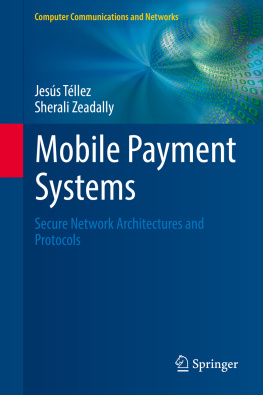Table of Contents
Mobile WiMAX
A Systems Approach to Understanding IEEE 802.16m Radio Access Technology
Sassan Ahmadi
Academic Press
To my wife Shahrnaz and my children Roya and Nima
Front Matter
Mobile WiMAX
A Systems Approach to Understanding IEEE 802.16m Radio Access Technology
Sassan Ahmadi

AMSTERDAM BOSTON HEIDELBERG LONDON NEW YORK OXFORD PARIS SAN DIEGO SAN FRANCISCO SINGAPORE SYDNEY TOKYO
Academic Press is an imprint of Elsevier

Copyright
Academic Press is an imprint of Elsevier
The Boulevard, Langford Lane, Kidlington, Oxford, OX5 1GB, UK
30 Corporate Drive, Suite 400, Burlington, MA 01803, USA
First published 2011
Copyright 2011 Elsevier Inc. All rights reserved.
No part of this publication may be reproduced or transmitted in any form or by any means, electronic or mechanical, including photocopying, recording, or any information storage and retrieval system, without permission in writing from the publisher. Details on how to seek permission, further information about the Publisher's permissions policies and our arrangement with organizations such as the Copyright Clearance Center and the Copyright Licensing Agency, can be found at our website: www.elsevier.com/permissions
This book and the individual contributions contained in it are protected under copyright by the Publisher (other than as may be noted herein).
Notices
Knowledge and best practice in this field are constantly changing. As new research and experience broaden our understanding, changes in research methods, professional practices, or medical treatment may become necessary.
Practitioners and researchers must always rely on their own experience and knowledge in evaluating and using any information, methods, compounds, or experiments described herein. In using such information or methods they should be mindful of their own safety and the safety of others, including parties for whom they have a professional responsibility.
To the fullest extent of the law, neither the Publisher nor the authors, contributors, or editors, assume any liability for any injury and/or damage to persons or property as a matter of products liability, negligence or otherwise, or from any use or operation of any methods, products, instructions, or ideas contained in the material herein.
British Library Cataloguing in Publication Data
Ahmadi, Sassan.Mobile WiMAX : a systems approach to understanding the IEEE
802.16m radio access network.
1. IEEE 802.16 (Standard) 2. Wireless communication systems. 3. Mobile communication systems.
I. Title
621.3'84-dc22
Library of Congress Control Number: 2010935393
ISBN: 978-0-12-374964-2
For information on all Academic Press publications visit our website at www.elsevierdirect.com
Printed and bound in the United States
10 11 12 11 10 9 8 7 6 5 4 3 2 1

Preface
Wireless communication comprises a wide range of technologies, services, and applications that have come into existence to meet the particular needs of users in different deployment scenarios. Wireless systems can be broadly characterized by content and services offered, reliability and performance, operational frequency bands, standards defining those systems, data rates supported, bi-directional and uni-directional delivery mechanisms, degree of mobility, regulatory requirements, complexity, and cost. The number of mobile subscribers has increased dramatically worldwide in the past decade. The growth in the number of mobile subscribers will be further intensified by the adoption of broadband mobile access technologies in developing countries such as India and China with large populations. It is envisioned that potentially the entire world population will have access to broadband mobile services, depending on economic conditions and favorable cost structures offered by regional network operators. There are already more mobile devices than fixed-line telephones or fixed computing platforms, such as desktop computers, that can access the Internet. The number of mobile devices is expected to continue to grow more rapidly than nomadic and stationary devices. Mobile terminals will be the most commonly used platforms for accessing and exchanging information. In particular, users will expect a dynamic, continuing stream of new applications, capabilities, and services that are ubiquitous and available across a range of devices using a single subscription and a single identity. Versatile communication systems offering customized and ubiquitous services based on diverse individual needs require flexibility in the technology in order to satisfy multiple demands simultaneously. Wireless multimedia traffic is increasing far more rapidly than voice, and will increasingly dominate traffic flows. The paradigm shift from predominantly circuit-switched air interface design to full IP-based delivery has provided the mobile users with the ability to more efficiently, more reliably, and more securely utilize packet-switched services such as e-mail, file transfers, messaging, browsing, gaming, voice-over Internet protocol, location-based, multicast, and broadcast services. These services can be either symmetrical or asymmetrical (in terms of the use of radio resources in the downlink or uplink) and real-time or non real-time, with different quality of service requirements. The new applications consume relatively larger bandwidths, resulting in higher data rate requirements.
In defining the framework for the development of IMT-Advanced and systems beyond IMT-Advanced radio interface technologies, it is important to understand the usage models and technology trends that will affect the design and deployment of such systems. In particular, the framework should be based on increasing user expectations and the growing demand for mobile services, as well as the evolving nature of the services and applications that may become available in the future. The trend toward integration and convergence of wireless systems and services can be characterized by connectivity (provision of an information pipe including intelligence in the network and the terminal), content (information including push and pull services as well as peer-to-peer applications), and e-commerce (electronic transactions and financial services). This trend may be viewed as the integration and convergence of information technology, telecommunications, and content, which has resulted in new service delivery dynamics and a new paradigm in wireless telecommunications, where value-added services have provided significant benefits to both the end users and the service providers.
Present mobile communication systems have evolved by incremental enhancements of system capabilities, and gradual addition of new functionalities and features to baseline IMT-2000 systems. The capabilities of IMT-2000 systems have continued to steadily evolve over the past decade as IMT-2000 technologies are upgraded and deployed (e.g., mobile WiMAX and the migration of UMTS systems to HSPA+). The IMT-Advanced and systems beyond IMT-Advanced are going to be realized by functional fusion of existing IMT-2000 system components, enhanced and new functions, nomadic wireless access systems, and other wireless systems with high commonality and seamless interworking. The systems beyond IMT-Advanced will encompass the capabilities of previous systems, as well as other communication schemes such as machine-to-machine, machine-to-person, and person-to-machine.











